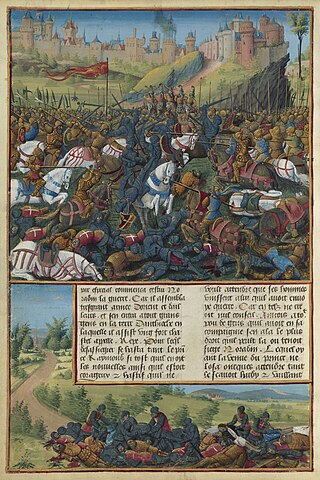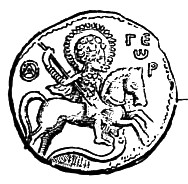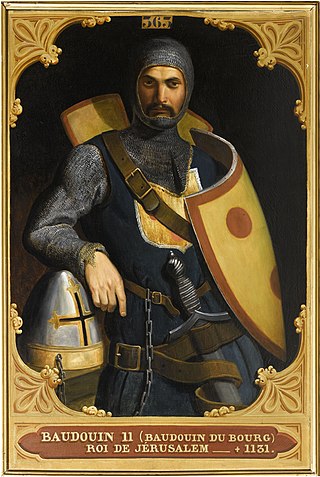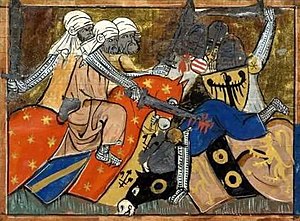Background
Antioch and the other Crusader States were constantly at war with the Muslim states of Northern Syria and the Jazeerah, principally Aleppo and Mosul. When Ridwan of Aleppo died in 1113, there was a period of peace, at least for a few years. However, Roger of Salerno, who was ruling Antioch as regent for Bohemond II, did not take advantage of Ridwan's death; likewise, Baldwin II, count of Edessa, and Pons, count of Tripoli, looked after their own interests and did not ally with Roger against Aleppo. In 1115, Roger defeated a Seljuk Turkish invasion force led by Bursuq ibn Bursuq at the Battle of Sarmin.
In 1117, Aleppo came under the rule of the Artuqid atabeg Ilghazi. In 1118, Roger captured Azaz, which left Aleppo open to attack from the Crusaders; in response, Ilghazi invaded the Principality in 1119. Roger marched out from Artah with Bernard of Valence, the Latin Patriarch of Antioch. Bernard suggested they remain there, as Artah was a well-defended fortress only a short distance away from Antioch, and Ilghazi would not be able to pass if they were stationed there. The Patriarch also advised Roger to call for help from Baldwin, now king of Jerusalem, and Pons, but Roger felt he could not wait for them to arrive.
Roger camped in the pass of Sarmada, while Ilghazi besieged the fort of al-Atharib. A force under Robert of Vieux-Pont set out to break the siege, and Ilghazi feigned a retreat, Robert's men were drawn out from the fort and ambushed.
Battle
Ilghazi was also waiting for reinforcements from Toghtekin, the Burid emir of Damascus, but he too was tired of waiting. Using little-used paths, his army quickly surrounded Roger's camp during the night of 27 June. The prince had recklessly chosen a campsite in a wooded valley with steep sides and few avenues of escape. Roger's army of 700 knights, 500 Armenian cavalry and 3,000 foot soldiers, including turcopoles, hastily formed into five divisions. These drew up in a V-shaped line with the tip farthest from the Muslim battle array. From left to right, the divisions were commanded by Robert of St. Lo, Prince Roger, Guy de Frenelle, Geoffrey the Monk and Peter. Meanwhile, Roger held back a sixth division under Renaud Mansoer to protect the Antiochene rear.
As the Muslim army waited, the qadi Abu al-Fadl ibn al-Khashshab, wearing his lawyer's turban but brandishing a lance, rode out in front of the troopers. At first they were incredulous at being harangued by a scholar but at the end of his passionate evocation of the duties and merits of the jihad warrior, according to Kamal ad-Din, the contemporary historian of Aleppo, these hardened professionals wept with emotion and rode into battle.
That morning, 28 June, the battle was begun by an archery duel between the Antiochene infantry, posted in front of the knights, and the Turkish bowmen. The crusader army was at first successful when the right-hand divisions of Peter and Geoffrey the Monk attacked and defeated the Artuqids opposed to them. Guy de Frenelle's center division had some success also, but the battle was soon decided on the left flank. Robert of St. Lo and the Turcopoles were driven back into Roger's division, disrupting it. A north wind blew dust in the faces of the Antioch knights and footmen, confusing them further. Soon, Artuqid flanking forces enveloped the crusaders.
During the fighting, Roger was killed by a sword in the face at the foot of the great jewelled cross which had served as his standard. The rest of the army was killed or captured; only two knights survived. Renaud Mansoer took refuge in the fort of Sarmada to wait for King Baldwin, but was later taken captive by Ilghazi. Among the other prisoners was likely Walter the Chancellor, who later wrote an account of the battle. The massacre led to the name of the battle, ager sanguinis, Latin for "the field of blood."
Aftermath
Ilghazi soon went on an alcoholic binge and did not advance to Antioch, where Patriarch Bernard was organizing whatever defense he could. Even so, because of the loss of the Antiochene field army, Atharib, Zerdana, Sarmin, Ma'arrat al-Numan and Kafr Tab rapidly fell into Muslim hands.
Ilghazi was defeated by Baldwin II of Jerusalem and Count Pons at the Battle of Hab on 14 August and Baldwin took over the regency of Antioch. Subsequently, Baldwin recovered some of the lost towns. Even so, the defeat at the Field of Blood left Antioch severely weakened, and subject to repeated attacks by the Muslims in the following decade. Eventually, the Principality came under the influence of a resurgent Byzantine Empire.
The Crusaders regained some of their influence in Syria at the Battle of Azaz six years later in 1125.

Year 1119 (MCXIX) was a common year starting on Wednesday of the Julian calendar.

Bohemond II was Prince of Taranto from 1111 to 1128 and Prince of Antioch from 1111/1119 to 1130. He was the son of Bohemond I, who in 1108 was forced to submit to the authority of the Byzantine Empire in the Treaty of Devol. Three years later, the infant Bohemond inherited the Principality of Taranto under the guardianship of his mother, Constance of France. The Principality of Antioch was administered by his father's nephew, Tancred, until 1111. Tancred's cousin, Roger of Salerno, managed the principality from 1111 to 1119. After Roger died in the Battle of the Field of Blood, Baldwin II of Jerusalem took over the administration of Antioch. However, he did acknowledge Bohemond's right to personally rule the principality upon reaching the age of majority.

Baldwin II, also known as Baldwin of Bourcq or Bourg, was Count of Edessa from 1100 to 1118, and King of Jerusalem from 1118 until his death. He accompanied his cousins Godfrey of Bouillon and Baldwin of Boulogne to the Holy Land during the First Crusade. He succeeded Baldwin of Boulogne as the second count of Edessa when he left the county for Jerusalem following his brother's death. He was captured at the Battle of Harran in 1104. He was held first by Sökmen of Mardin, then by Jikirmish of Mosul, and finally by Jawali Saqawa. During his captivity, Tancred, the Crusader ruler of the Principality of Antioch, and Tancred's cousin, Richard of Salerno, governed Edessa as Baldwin's regents.

Pons was count of Tripoli from 1112 to 1137. He was a minor when his father, Bertrand, died in 1112. He swore fealty to the Byzantine Emperor Alexios I Komnenos in the presence of a Byzantine embassy. His advisors sent him to Antioch to be educated in the court of Tancred of Antioch, ending the hostilities between the two crusader states. Tancred granted four important fortresses to Pons in the Principality of Antioch. Since Pons held his inherited lands in fief of the kings of Jerusalem, Tancred's grant strengthened the autonomy of the County of Tripoli. On his deathbed, Tancred also arranged the marriage of his wife, Cecile of France, to Pons.

The Battle of Azaz was a major battle fought between king Baldwin II's crusader forces and the Muslims, led by Aq-Sunqur al-Bursuqi, the Seljuq atabeg of Mosul on 11 June 1125. Being one of the bloodiest confrontations before the Second Crusade, the battle resulted in a decisive victory for the Crusaders, causing disturbances of power in the Levant and weakened Seljuk domination in the area. Contemporary chronicler Matthew of Edessa even states that the remnants of al-Bursuqi's army were chased all the way to Aleppo. The battle effectively lifted the siege of the town of Azaz and prevented it from falling to Turkoman hands.

The Battle of Inab, also called Battle of Ard al-Hâtim or Fons Muratus, was fought on 29 June 1149, during the Second Crusade. The Zengid army of the atabeg Nur al-Din Zengi destroyed the combined army of Prince Raymond of Poitiers and the Assassins of Ali ibn-Wafa. The Principality of Antioch was subsequently pillaged and reduced in size as its eastern border was pushed west.

The Battle of Harran took place on 7 May 1104 between the Crusader states of the Principality of Antioch and the County of Edessa, and the Seljuk Turks. It was the first major battle against the newfound Crusader states in the aftermath of the First Crusade, marking a key turning point against Frankish expansion. The battle had a disastrous effect on the Principality of Antioch as the Turks regained territory earlier lost.

Roger of Salerno was regent of the Principality of Antioch from 1112 to 1119. He was the son of Richard of the Principate and the 2nd cousin of Tancred, Prince of Galilee, both participants on the First Crusade. He became regent of Antioch when Tancred died in 1112; the actual prince, Bohemond II, was still a child. Like Tancred, Roger was almost constantly at war with the nearby Muslim states such as Aleppo. In 1114 there was an earthquake that destroyed many of the fortifications of the principality, and Roger took great care to rebuild them, especially those near the frontier.
Najm al-Din Ilghazi ibn Artuq was the Turkoman Artukid ruler of Mardin from 1107 to 1122. He was born into the Oghuz tribe of Döğer.

The Battle of Sarmin, also known as the Battle of Tell Danith, took place on September 14, 1115 with Roger of Salerno's Crusader army surprising and routing the Seljuk Turkish army of Bursuq ibn Bursuq of Hamadan. It is also known as the First Battle of Tell Danith, distinguishing it from the Battle of Hab of 1119, the Second Battle of Tell Danith.
Abu'l-Faḍl (Abu'l-Hasan) ibn al-Khashshab was the Shi'i qadi and rais of Aleppo during the rule of the Seljuk emir Radwan.

The Battle of Hab, also known as the Second Battle of Tell Danith, occurred on August 14, 1119, where a Crusader army commanded by King Baldwin II of Jerusalem won a disputed victory over a Muslim army led by Ilghazi of Mardin since the Muslim army claimed it as a victory also. The battle stabilized the Principality of Antioch, which had suffered a disastrous defeat only weeks before. Baldwin II managed to re-take all of the castles conquered by Ilghazi and prevented him from marching on Antioch.
In the Battle of Shaizar in 1111, a Crusader army commanded by King Baldwin I of Jerusalem and a Seljuk army led by Mawdud ibn Altuntash of Mosul fought to a tactical draw, but a withdrawal of Crusader forces.
In the Battle of al-Sannabra (1113), a Crusader army led by King Baldwin I of Jerusalem was defeated by a Muslim army sent by the Sultan of the Seljuk Turks and commanded by Mawdud ibn Altuntash of Mosul.

The timeline of the Principality of Antioch is a chronological list of events of the history of the Principality of Antioch.
Qasīm al-Dawla Sayf al-Dīn Abū Saʿīd Āqsunqur al-Bursuqī, also known as Aqsunqur al-Bursuqi, Aqsonqor il-Bursuqi, Aksunkur al-Bursuki, Aksungur or al-Borsoki, was the Seljuk Turkoman atabeg of Mosul from 1113–1114 and again from 1124–1126.
Bursuq ibn Bursuq, also known as Bursuk ibn Bursuk, was the emir of Hamadan.
Robert fitz-Fulk the Leper, also known as Robert Fulcoy, Robert the Leprous, or Robert of Saone, was a powerful baron in the Principality of Antioch.
Rainald I Masoir, also known as Renaud I Masoir, was constable of the Principality of Antioch from around 1126, and also baillif of the principality from 1132. Although he was a prominent military commander and held important offices, most details of his life are unknown. He received his first estates in the southern regions of Antioch in the 1110s. He made the strong fortress of Margat the center of his domains. He regularly witnessed the Antiochene rulers' diplomas from the 1120s. He was most probably still the actual ruler of the principality when he died.
The siege of Aleppo by Baldwin II of Jerusalem and his allies lasted from 6 October 1124 to 25 January 1125. It ended in a Crusader withdrawal following the arrival of a relief force led by Aqsunqur al-Bursuqi.











